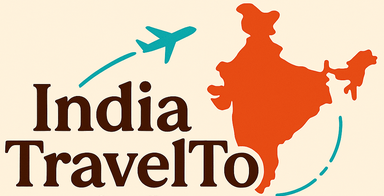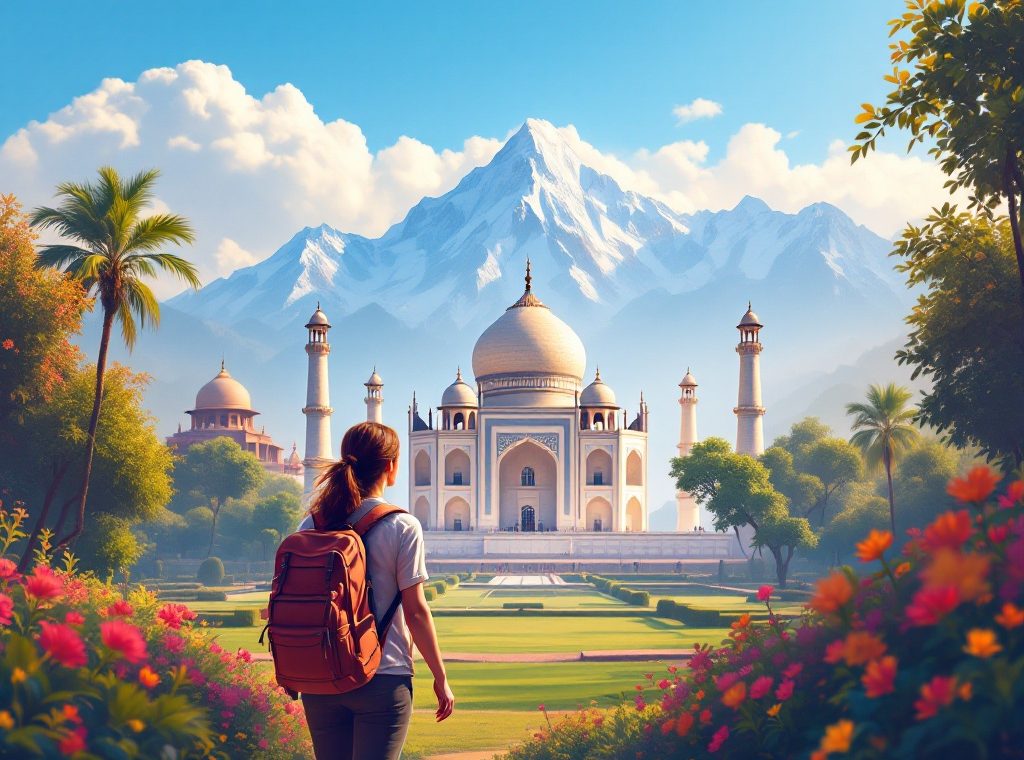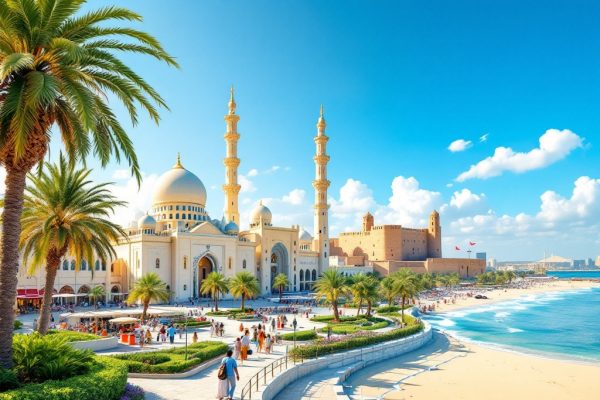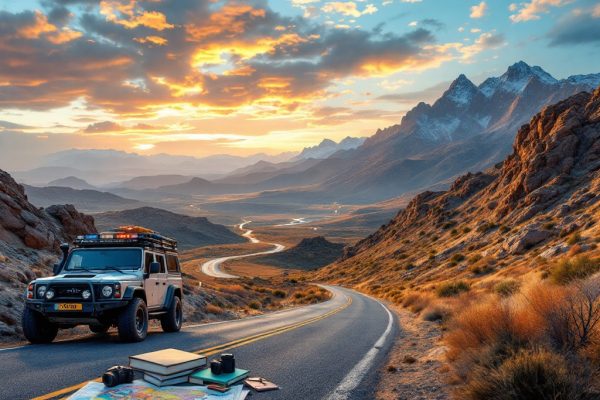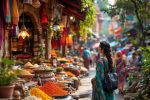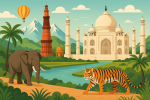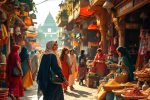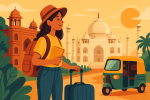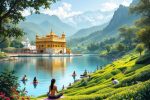Solo Travel to India: The Ultimate Guide
Dreaming of an enriching solo adventure? Discover India, a vibrant and affordable Asian gem perfect for self-discovery. From the Taj Mahal to the Himalayas, explore diverse landscapes and rich cultural heritage. Learn how to plan your trip, navigate local customs, stay safe, and savor delicious cuisine. Unforgettable experiences await. Start your Indian adventure today!
Important information
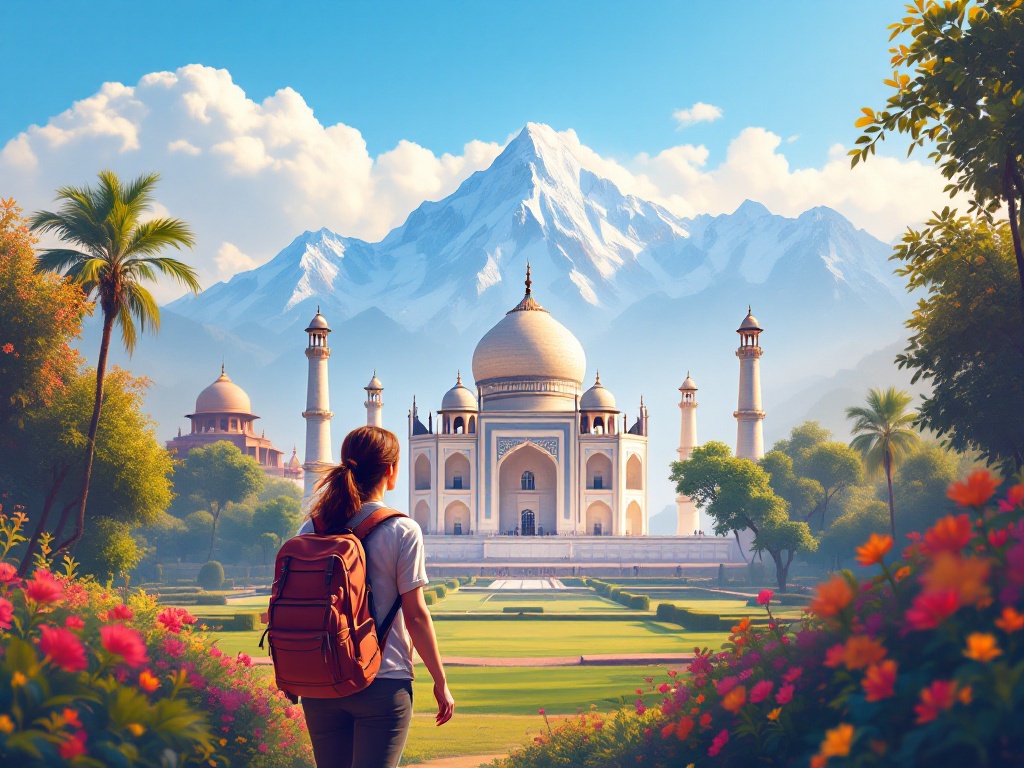
- India is a budget-friendly destination with affordable food, lodging, and transport, often costing $20-$30 per day.
- Research local customs and current events before traveling, and learn basic Hindi phrases for easier communication.
- Prioritize safety by dressing modestly, avoiding walking alone at night, and using reliable transport. Obtain a local SIM card upon arrival.
- Consume bottled or filtered water and eat freshly cooked meals to prevent illness. Be cautious with street food, opting for busy vendors.
- India offers diverse experiences, from exploring ancient sites and vibrant cities to tranquil beaches and mountain treks. Plan a flexible itinerary to allow for spontaneous adventures.
Introduction to Solo Travel in India
Embarking on a solo trip through India can be an incredibly enriching experience. An open mind and adaptable nature will unlock the country’s diverse landscapes, vibrant cultures, and unique traditions, making it an ideal destination for independent adventurers.
Research and Preparation. Start by researching specific regions and familiarizing yourself with local customs, including basic Hindi phrases and essential safety tips. This groundwork will ensure a smoother, more immersive journey, fostering personal growth and creating unforgettable memories.
Cultural Awareness. Stay informed about cultural nuances, current events, and potential risks. Understanding local customs enables respectful interactions with residents, enriching your experience.
Embrace the Diversity. India offers a wealth of breathtaking landscapes and vibrant cultures, all waiting to be discovered. With careful planning, your solo journey through India will be truly transformative.
Why Choose India for Solo Travel?
India is a remarkably affordable Asian travel destination, offering transformative experiences, especially for Westerners. Its diverse landscapes, rich culture, and spiritual depth are ideal for self-discovery and personal growth. The low cost of travel allows for extended trips, enabling exploration of numerous regions. This unique culture, vastly different from Western societies, enhances its transformative impact.
Discover India’s Rich Heritage
From the Taj Mahal and ancient forts to Himalayan treks and spiritual sites like Varanasi and Rishikesh, India offers a myriad of attractions. These locations provide opportunities for introspection and self-discovery.
Explore Diverse Landscapes
India’s varied landscapes encompass beaches, deserts, and mountains, showcasing the country’s rich history and heritage through its architecture, art, and traditions. Experience the beauty and diversity of India’s natural wonders.
Affordable Travel Options
Budget-friendly accommodations, food, and transport make India a cost-effective travel destination. Delicious street food and affordable hostels allow travelers to extend their stays and explore more of this captivating country.
A Journey of Transformation
For Western travelers, India presents a stark cultural contrast. Exposure to different customs and traditions can be life-altering, encouraging introspection and broadening perspectives. Experiences like yoga retreats and spiritual exploration further contribute to personal growth.
Incredible Offerings and Attractions
India welcomes solo travelers to explore its ancient forts and palaces, experience vibrant festivals, and discover serene temples. Find inner peace at a yoga and meditation retreat, or encounter diverse wildlife. From the majestic Taj Mahal to the colorful Holi festival, and treks through the Himalayas, India offers a rich tapestry of experiences. Discover the beauty of India’s landscapes, from the snow-capped Himalayas to the tropical beaches of Goa. Experience the rich culture by visiting ancient forts, palaces, and temples. Partake in the vibrant festivals and immerse yourself in the spiritual traditions of yoga and meditation. Encounter incredible wildlife, from tigers and elephants to diverse bird species. India offers an unforgettable journey of self-discovery.
Affordability: One of the Cheapest Asian Destinations
Traveling in India on a BudgetIndia is a great choice for travelers looking for affordable adventures. You can easily experience its rich culture and diverse landscapes without breaking the bank. Here’s why:
Accommodation
India offers a wide range of budget-friendly options, including hostels, guesthouses, and homestays. These are readily available across the country.
Transportation
An extensive public transport network of trains and buses makes getting around easy and affordable. You can explore the country’s many regions without spending a fortune on transportation.
Food
India’s street food scene is a must-try, offering a delicious culinary experience at incredibly low prices. Local restaurants also provide tasty meals that won’t strain your budget.
Daily Budget
A daily budget of $20-$30 can comfortably cover your basic expenses, including accommodation, food, and transportation. Of course, you can choose to spend more if you prefer extra comforts.
Transformative Experiences for Western Travelers
India is a transformative experience for Western travelers. Encountering new cultures and ancient traditions fosters personal growth, while spiritual practices broaden perspectives. The country’s vibrant colors and bustling markets ignite inspiration, and its diverse landscapes captivate the senses. Connect with local people, experience their daily lives, and create unforgettable memories. In India, you’ll discover both yourself and a wider world.
Planning Your Solo Trip to India
Before your trip to India, learn about the country’s diverse culture. Understanding local customs and current events will make your trip better and safer, helping you easily adapt to local norms. Be aware of any regional issues that might affect your plans for a smoother, more rewarding journey. Showing respect for local customs, like dressing modestly at religious sites and using proper greetings, helps create positive interactions.Planning your trip involves practical steps:
- Book your flights.
- Get your visa.
- Create a flexible itinerary.
- Reserve train tickets in advance, especially during peak season.
- Get travel insurance for medical emergencies, lost luggage, and unexpected cancellations.
- Book accommodations beforehand, especially during festivals.
India offers many transportation options, including trains, buses, and domestic flights. While a planned itinerary is helpful, staying flexible lets you enjoy unexpected discoveries and explore more.Remember these essential documents:
- Valid passport,
- Indian visa,
- Copies of important papers (itinerary, insurance policy) kept separate from originals,
- Comprehensive travel insurance covering medical emergencies, trip cancellations, and lost belongings.
Choose an insurance policy that covers potential risks in India, including medical repatriation.
Research: Understanding Culture and News
Planning a trip to India? Understanding local customs and staying informed about current events are crucial for a smooth and enjoyable experience. Learning about Indian culture will help you avoid unintentional offenses, while keeping up-to-date on recent news can significantly influence your itinerary. This awareness empowers you to make informed decisions about your destinations and activities, ensuring both your safety and a more enriching travel experience.
Travel Planning and Logistics
Planning a smooth trip involves several key steps. First, research your destinations thoroughly, including available transportation and accommodation options. Second, book flights and train tickets in advance, especially if traveling during peak season. Consider using a travel agent for complex itineraries. Third, check visa requirements and apply if necessary. Fourth, pack light, considering the local climate and customs. Fifth, inform your bank and phone provider of your travel dates to avoid service interruptions. Sixth, download useful apps for navigation, translation, and currency conversion. Lastly, prepare for unexpected situations with a backup plan.
Important Documents and Travel Insurance
Ensure you pack your valid passport, Indian visa, and photocopies of each – these are essential.
Travel insurance is crucial for covering emergencies like medical issues, lost luggage, or trip cancellations. A printed itinerary and emergency contact information are also important.
Top Destinations for Solo Travelers in India
Rajasthan: A State of Majesty
Jaipur, the “Pink City,” captivates with the Hawa Mahal and Amber Fort. Udaipur, the “City of Lakes,” boasts the Lake Palace and City Palace. Jodhpur, the “Blue City,” is home to the Mehrangarh Fort. The sacred city of Pushkar is known for its camel fair and Brahma Temple.
Spiritual and Serene Destinations
Varanasi, on the Ganges, is a key Hindu pilgrimage site. Rishikesh, the “Yoga Capital of the World,” offers numerous ashrams and yoga retreats.
Southern Delights
Pondicherry blends Indian and European cultures. Alleppey offers tranquil backwaters and houseboat stays. Goa features beaches, nightlife, and Portuguese influences.
Mountain Escapes
Manali is a haven for trekking and skiing. McLeodGanj showcases Tibetan culture. Spiti Valley captivates with its stark landscapes and ancient monasteries.
Urban Adventures
Mumbai thrives on Bollywood and colonial architecture. Kolkata is a cultural hub rich in literature and art.
India’s Capital
New Delhi blends old and new, from the Red Fort to modern infrastructure.
Rajasthan: Jaipur, Udaipur, Jodhpur, and Pushkar
Jaipur, the “Pink City,” is renowned for its historical palaces, such as the majestic Hawa Mahal and Amber Fort.
Jodhpur, the “Blue City,” boasts the impressive Mehrangarh Fort.
Udaipur, the “City of Lakes,” offers scenic boat rides and the stunning architecture of the Lake Palace.
The holy city of Pushkar provides a unique experience with its sacred lake and vibrant camel fair.
Spiritual and Cultural Hubs: Varanasi and Rishikesh
Varanasi, located on the Ganges River, is renowned for its ancient spiritual traditions. Rishikesh, nestled in the Himalayan foothills, is known as the “Yoga Capital of the World”. Both destinations offer unique opportunities for self-discovery and cultural immersion.
Southern Gems: Pondicherry, Alleppey, and Goa
Pondicherry, a former French colony, offers a unique blend of Indian and French cultures.
Alleppey, often called the “Venice of the East,” provides tranquil backwater cruises.
Goa, in contrast, is famous for its beaches and lively nightlife, drawing a diverse range of visitors.
Hill Stations and Valleys: Manali, McLeodGanj, and Spiti Valley
Manali excites adventure seekers with skiing and trekking. McLeodGanj, the residence of the Dalai Lama, provides a unique mix of Tibetan culture with a breathtaking mountain backdrop. Spiti Valley attracts visitors with its stark landscapes, high-altitude monasteries, and challenging treks.
Urban Adventures: Mumbai, Kolkata, and New Delhi
Mumbai boasts iconic landmarks like the Gateway of India and the Chhatrapati Shivaji Maharaj Terminus, offering a unique and exciting experience for solo travelers.
Kolkata captivates visitors with its stunning colonial architecture and vibrant arts scene, presenting a unique experience for solo travelers.
New Delhi presents historical treasures such as the Red Fort and Humayun’s Tomb, providing a unique and exciting experience for solo travelers.
Accommodation and Transportation Options
Traveling solo in India offers a unique opportunity to experience the country’s rich culture and diverse landscapes. A range of accommodations caters to every budget, from budget-friendly hostels to immersive homestays and guesthouses, offering a taste of local life.India’s extensive train network makes traveling across the country efficient and affordable. For swift, comfortable journeys, opt for the Shatabdi or Rajdhani Express. Alternatively, local buses, auto-rickshaws, and taxis are readily available for shorter trips, offering greater flexibility. Booking train tickets online is advisable, especially during peak season, to secure your seat. This will save you time and potential hassle.
Budget Accommodations: Hostels and Homestays
India welcomes travelers of all budgets with a variety of affordable accommodations. Backpackers often prefer hostels, enjoying dorm-style rooms and communal spaces perfect for meeting fellow travelers. For a more immersive cultural experience, consider a homestay. This offers the chance to live with an Indian family and experience local customs firsthand. Hostels and homestays remain economical options for exploring India’s rich cultural heritage.
Transportation: Train Travel and Local Transport
Train travel is a cost-effective and popular way to explore India. For speed and comfort, consider the Shatabdi or Rajdhani Express. First-time travelers might prefer 2AC (air-conditioned second class) or CC (chair car). Book tickets and plan your itinerary via the official railway website. For shorter journeys, buses are a practical alternative. Taxis provide convenient door-to-door service. Regardless of your chosen mode, advance planning will enhance your experience navigating India’s varied landscapes.
Cultural Etiquette and Local Traditions
Traveling respectfully means embracing local customs. Dress modestly, particularly at religious sites. For women, this often includes loose clothing that covers shoulders and knees. Before entering temples or homes, remove your shoes and offer a “Namaste” greeting. Use your right hand for eating and exchanging items. Public displays of affection are generally best avoided. While respecting diverse religious traditions is crucial, remember customs can vary regionally. Ultimately, showing consideration enhances everyone’s experience.
Dress modestly, particularly when visiting religious sites. For women, this often involves wearing loose clothing that covers the shoulders and knees.
Remove your shoes before entering temples or homes, and offer a “Namaste” greeting.
Use your right hand for eating and exchanging items.
Avoid public displays of affection.
Respect diverse religious traditions. Remember that customs can vary regionally.
Showing consideration enhances everyone’s experience.
Practicing Cultural Etiquette
When visiting temples or homes, remove your shoes. Eat and handle money with your right hand. Use a simple “Namaste” as a respectful greeting. Avoid public displays of affection. Dress modestly, particularly at religious sites. Be polite and reserved with strangers. Learning about dining etiquette, for instance, demonstrates cultural sensitivity. Respect diverse religions and traditions, as understanding local customs shows respect and enriches your experience.
Dress Code: Modest Dress for Women Travelers
Dressing modestly in India demonstrates respect for local customs, especially in rural areas and religious sites. This involves covering your shoulders, legs, and cleavage. Avoid tight, sheer, or revealing clothing. Choose loose, flowing garments like loose-fitting pants or long skirts. Maintaining a respectful demeanor is also important. Remember to observe and adapt to regional variations in customs.
Culinary Experiences and Food Safety
North Indian cuisine offers a delightful vegetarian feast, from lentil soups (dal) and vegetable curries to various breads like roti and naan. Many restaurants also accommodate vegan diets. Staying healthy while exploring these culinary delights requires vigilance.
Staying Healthy While Enjoying North Indian Cuisine
To avoid any health issues, follow these simple precautions:
- Choose bottled or filtered water, and avoid tap water.
- Skip ice unless it’s from a purified source.
- Prioritize freshly cooked meals.
- Avoid raw foods like salads.
Choosing the Right Dining Experience
For a safe and enjoyable culinary experience:
- Opt for bustling restaurants, as high turnover suggests fresh ingredients.
- Street food can be a fantastic experience, but ensure it’s freshly made and from a popular vendor.
Savor your culinary adventure!
Exploring North Indian Cuisine and Vegetarian Diet
North Indian cuisine offers a wide variety of vegetarian dishes. Many recipes include paneer, a fresh Indian cheese, and yogurt, such as the popular palak paneer, a spinach and cheese dish. Creamy dal makhani is a flavorful lentil-based dish, while malai kofta features savory vegetable balls in a rich sauce. Beyond dairy, North Indian cuisine is known for its aromatic spices, including cumin, coriander, turmeric, and garam masala, which create complex and flavorful dishes. These curries are often served with flatbreads like roti and naan, perfect for enjoying every bit of the meal.
Food Safety Tips: Avoiding Delhi Belly
When visiting a foreign country, prioritize your health by consuming bottled or filtered water and avoiding ice unless its source is purified water. Focus on freshly cooked meals and steer clear of raw foods like salads. If you desire fresh produce, select busy restaurants or bustling food stalls. Popular street food vendors who cook meals in your presence are excellent options.
Safety Tips for Solo Travelers in India
Traveling safely involves staying aware of your surroundings and trusting your instincts. Dress respectfully and consider a local SIM card for easy communication and access to information. Confidence can deter scams, but avoid walking alone at night in unfamiliar areas. Stick to safe, tourist-friendly locations and use reliable transportation. Keep emergency contacts readily available.
General Safety Advice
- Be mindful of your surroundings.
- Dress respectfully.
- Get a local SIM card for easy communication.
- Project confidence to deter scams.
- Avoid walking alone at night in unfamiliar areas.
- Use reliable transportation.
- Keep emergency contacts accessible.
Additional Safety Tips
- Be cautious of common tourist traps.
- Avoid walking alone after dark, especially in isolated areas.
- Address unwanted attention politely but firmly.
- Seek help from locals or authorities if you feel unsafe.
- Learning basic Hindi can be helpful.
Safety Tips for Solo Female Travelers
- Dress modestly to respect local customs and blend in.
- Use ride-sharing services for security and route tracking.
- Share your itinerary and maintain regular contact with someone back home.
- Join group activities or tours, especially upon arrival, to meet other travelers.
Staying Safe: Common Sense and Precautionary Measures
Trust your instincts and be mindful of your surroundings. Dress modestly to honor local customs.
Projecting confidence, particularly in unfamiliar areas, can deter unwanted attention. Be wary of common tourist traps.
A local SIM card will simplify communication and information access.
For your safety, especially as a woman, avoid celebrating festivals like Holi alone.
Dealing with Scams and Unwanted Attention
Stay aware of your surroundings and project confidence to discourage unwanted attention.
Be assertive. A firm “no” can often diffuse a situation.
Create physical distance if you feel uncomfortable.
Dress modestly to minimize unwanted attention.
If a situation escalates, don’t hesitate to seek assistance from locals or fellow travelers.
Solo Female Travel: Dress Appropriately and Safety Tips
Dress respectfully, keeping local customs in mind to blend in and avoid unwanted attention.
Stay aware of your surroundings and trust your gut feeling.
Avoid walking alone at night, particularly in unfamiliar areas.
A local SIM card can be invaluable, providing easy communication and access to important information.
Before you go, research your destinations thoroughly, focusing on safe areas for tourists.
Use reliable transportation like pre-booked taxis or ride-sharing apps.
Share your itinerary with family or friends, keeping them updated on your whereabouts.
If a situation makes you uncomfortable, remove yourself immediately.
Be cautious about what you share on social media, avoiding real-time location updates to protect your privacy and safety.
Benefits and Challenges of Solo Travel in India
Advantages of Solo Travel in India
Embarking on a solo journey through India offers incredible opportunities for self-discovery and personal growth. Crafting your own itinerary allows you to fully immerse yourself in the vibrant local culture, engaging directly with the people and experiencing the country at your own pace. This fosters independence and builds confidence.
Challenges of Solo Travel in India
Traveling alone in India also presents unique challenges. The country’s rich and diverse traditions can sometimes lead to culture shock, and navigating rural areas can be difficult. Limited infrastructure and language barriers can pose obstacles. Safety, particularly for women, remains a concern. While loneliness can be a factor, connecting with fellow travelers and locals can greatly enrich the experience. Careful planning is key to mitigating these challenges and ensuring a rewarding solo adventure.
Opportunities for Personal Growth and Adventure
A solo trip through India is a profoundly enriching experience, offering a unique opportunity for self-discovery and genuine adventure. Navigating the unfamiliar landscapes and vibrant cultures cultivates resilience and independence. Overcoming the inevitable challenges empowers you, while embracing spontaneity unlocks unexpected and enriching encounters. These unique experiences broaden your horizons, fostering personal growth and pushing your boundaries, ultimately creating lifelong memories.
Challenges: Culture Shock and Navigating Rural Areas
Traveling to India, especially its rural areas, can be a rewarding but challenging experience for Westerners due to significant cultural differences. To make your journey smoother, consider these essential tips:
Learn basic Hindi phrases. Even simple greetings can create positive interactions and bridge the language barrier often encountered in rural India.
Research local customs and etiquette. India’s rich traditions differ significantly from Western norms. Understanding these differences can help you avoid cultural misunderstandings and show respect for local practices.
Prioritize food and water safety. To prevent illness, opt for bottled water and exercise caution when consuming street food, especially in areas with limited infrastructure.
Pre-book travel and accommodations. This is particularly crucial in less-developed regions where availability might be limited. Pre-booking ensures a less stressful journey and allows you to focus on experiencing the vibrant culture.
